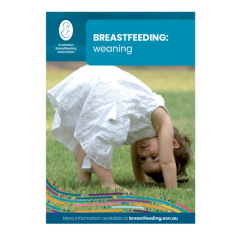How you wean your child will depend on their age and how quickly you want to stop breastfeeding

Weaning involves gradually reducing the number of feeds your baby or child is taking. As feeds reduce in length and amount, your milk supply will also gradually decrease.
Weaning takes time
If you’ve been feeding for a while, you will know that your breasts don’t stop making milk just because you stop feeding your baby. If you need to stop feeding quickly, you will need to take steps to reduce your supply.
A lot of mums choose to wean slowly.
It gives your child time to adjust.
You don't need to express for comfort. Slow weaning helps you to avoid overfull breasts and reduces the risk of mastitis.
It gives you both flexibility. For example, if your child gets sick you can go back to more breastfeeds until it passes.
Occasional breastfeeds are a good way to soothe and comfort an upset child.
Do I need to replace the breastfeeds?
Whether you replace the feeds with formula, cows' milk or water will depend on the age of your child and the other food and drinks they are having. Australian guidelines recommend:
If your baby is less than 12 months of age they need to have breastfeeds replaced with formula.1 Your child health nurse can provide more information.
If your child is older than 12 months of age, they can have cows' milk as a drink. Toddler formulas are not recommended2 or needed.
Current guidance from the World Health Organization (WHO) says that either formula or pasteurised animal milks (such as cows' milk) can be used from 6 months if a baby is no longer breastfed.3
Replacement feeds of formula, cows’ milk or water can be offered in a bottle or a cup.
Ways to approach weaning
Drop one breastfeed at a time.
This could be the feed that you find most difficult, the one your child seems least interested in or the one that is most convenient for you. Give your breasts a few days to settle, then choose another feed to replace and so on. Cut out one breastfeed every few days, or one each week. How often you drop feeds may depend on your own comfort and how willing your child is to cooperate.
Your baby or child may feel unsettled when weaning begins. Make sure you still spend plenty of time together and give them lots of cuddles.
Reduce the amount of breastmilk at each feed.
With this approach, if your baby is younger than 6 months, offer infant formula before breastfeeds. Your child health nurse can advise you on amounts. If your baby is older than 6 months, you can feed solids and other drinks of your choice according to the above guidelines and finish with a breastfeed if needed for your comfort.
Encouraging the weaning
- Offer one breast only at each feed and give your baby plenty of other drinks.
- Feed your baby according to a fixed routine, if you can.
- If your breasts become very full, hand express or use a breast pump until you are comfortable. Express only what you need to so your supply isn't built up again.
- Check both breasts every day for lumps, sore areas or redness. Treat any signs of breast inflammation early so you don't get mastitis.
If you are weaning a toddler or older child, you may like some extra tips.
Sometimes weaning happens sooner than you expect or want
Some mums find weaning happens before they are ready, or more quickly than they had planned. If this happens, you may feel disappointed, unwanted or sad that this phase of your baby’s life has passed. This may be especially so if you were looking forward to many more months of enjoyable breastfeeding.
If your baby does wean sooner than you would have liked, take the time to work through your feelings and grieve the end of this phase.
Breastfeeding is just one part of being a loving mum. You and your baby can still enjoy lots of cuddles and closeness knowing that you have given them a great start to life that breastfeeding provides.
© Australian Breastfeeding Association June 2025
Read more about weaning
Evidence-led info and practical tips from our Breastfeeding Information Series
Breastfeeding: weaning

- National Health and Medical Research Council. (2013). Australian dietary guidelines. https://www.nhmrc.gov.au/adg
- National Health and Medical Research Council. (2012). Infant feeding guidelines: Information for health workers. https://www.nhmrc.gov.au/about-us/publications/ infant-feeding-guidelines-information-health-workers
- World Health Organization. (2023). WHO guideline for complementary feeding of infants and young children 6–23 months of age. https://www.who.int/publications/i/item/9789240081864



